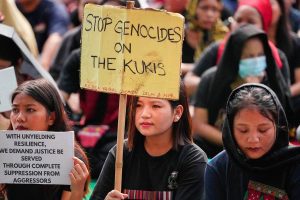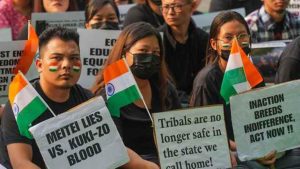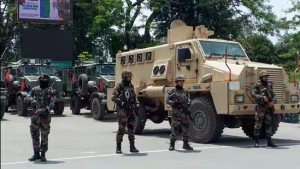Manipur– The Centre has announced a significant breakthrough in addressing the ongoing ethnic crisis in Manipur, with Kuki civil society groups agreeing to facilitate the Manipur free movement along key transportation corridors. This development comes just days ahead of Prime Minister Narendra Modi’s anticipated visit to the violence-torn state on September 13, marking his first visit since ethnic violence erupted in May 2023.
The announcement represents the most substantial step toward normalcy in Manipur since the conflict began, potentially paving the way for comprehensive peace between the warring Kuki and Meitei communities. The timing of this Manipur free movement initiative coincides strategically with the Prime Minister’s upcoming visit, signaling the Centre’s commitment to resolving the protracted ethnic crisis.
Alongside the Manipur free movement announcement, the Centre has finalized a new Suspension of Operations (SoO) agreement with Kuki militant groups, incorporating stringent conditions designed to ensure lasting peace. The tripartite agreement involves representatives from the Ministry of Home Affairs, the Manipur government, and the Kuki National Organisation (KNO) and United People’s Front (UPF).
 Under the revised terms, militant groups have committed to relocating seven designated camps away from conflict-vulnerable areas, particularly those near Meitei-inhabited regions. This relocation addresses a long-standing Meitei demand and represents a crucial component of the broader Manipur free movement strategy.
Under the revised terms, militant groups have committed to relocating seven designated camps away from conflict-vulnerable areas, particularly those near Meitei-inhabited regions. This relocation addresses a long-standing Meitei demand and represents a crucial component of the broader Manipur free movement strategy.
The agreement mandates that SoO groups deposit their weapons at the nearest Central Reserve Police Force (CRPF) or Border Security Force (BSF) camps. Additionally, all cadres must undergo stringent physical verification to identify and de-list any foreign nationals within their ranks. These measures aim to enhance security and facilitate smoother of the Manipur free movement across previously restricted areas.
A cornerstone of the new SoO agreement involves explicit recognition of Manipur’s territorial integrity. This provision directly addresses separatist aspirations among certain Kuki factions who have advocated for a separate administrative zone. By agreeing to respect territorial boundaries, the militant groups have demonstrated their commitment to working within the existing constitutional framework for achieving the Manipur free movement and lasting peace.
Also Read: Manipur free movement
Similar: List of more on Manipur
The establishment of a Joint Monitoring Group represents another critical element of the peace framework. This body will closely monitor compliance with ground rules, ensuring that violations are addressed firmly and potentially triggering reviews of the SoO agreement itself. Such oversight mechanisms are essential for maintaining the momentum toward sustainable Manipur free movement and ethnic reconciliation.


The KZC’s statement specifically addressed their appeal to Kangpokpi district residents, clarifying that cooperation with security forces should not be misinterpreted as endorsing unrestricted movement across buffer zones. These buffer zones, which separate Meitei and Kuki-Zo areas, remain heavily guarded by security forces and are considered crucial for maintaining peace during the Manipur free movement implementation phase.
The Council stressed that ensuring safe passage along national highways remains the Centre’s responsibility, not that of local communities or civil society organizations. This position reflects the complex dynamics surrounding the Manipur free movement and the careful balance required between community cooperation and government accountability.
The Manipur free movement negotiations have revealed significant internal divisions within the Kuki-Zo community regarding representation and legitimacy. The Zomi Council, based in Churachandpur, has questioned the KZC’s authority to represent the broader community in discussions with the Centre.
Mary Jones Vung, a Zomi Council leader, criticised the Centre’s approach, alleging a “divide and rule” strategy. The Zomi Council, which has operated for decades compared to the KZC’s establishment in November, argues that established stakeholders have been excluded from crucial Manipur free movement discussions.
This representational dispute highlights the complex ethnic and political landscape that complicates efforts to achieve comprehensive Manipur free movement. The rejection of the umbrella term ‘Kuki’ by some groups and ongoing tensions over community representation pose additional challenges to sustaining peace initiatives.
 The stretch of NH-02 passing through Kangpokpi district remains particularly sensitive, having witnessed significant violence during previous attempts to enforce Manipur free movement. The March 8 incident, which resulted in one death and multiple injuries during clashes between protesters and security forces, underscores the volatility surrounding transportation corridors.
The stretch of NH-02 passing through Kangpokpi district remains particularly sensitive, having witnessed significant violence during previous attempts to enforce Manipur free movement. The March 8 incident, which resulted in one death and multiple injuries during clashes between protesters and security forces, underscores the volatility surrounding transportation corridors.
The Centre’s concern extends beyond Kuki areas to include Naga-dominated regions. The United Naga Council has announced a trade embargo beginning September 8, protesting the suspension of the Free Movement Regime with Myanmar and border fencing initiatives. This development adds another layer of complexity to achieving comprehensive Manipur free movement.
The current Manipur free movement initiative represents a carefully orchestrated diplomatic effort timed to coincide with the Prime Minister’s visit. Success in this endeavour could provide a template for similar interventions in other conflict-affected regions of Northeast India.
The relocation of militant camps from valley fringes to hill areas addresses Meitei concerns about security while potentially reducing friction points between communities. However, the ultimate success of Manipur free movement will depend on sustained political will, community cooperation, and effective implementation of security measures.
As Manipur approaches this critical juncture, the Manipur free movement agreement represents both an opportunity for lasting peace and a test of the Centre’s capacity to navigate complex ethnic dynamics in India’s Northeast. The coming weeks will determine whether this initiative can translate into genuine reconciliation between communities that have endured months of devastating conflict.

